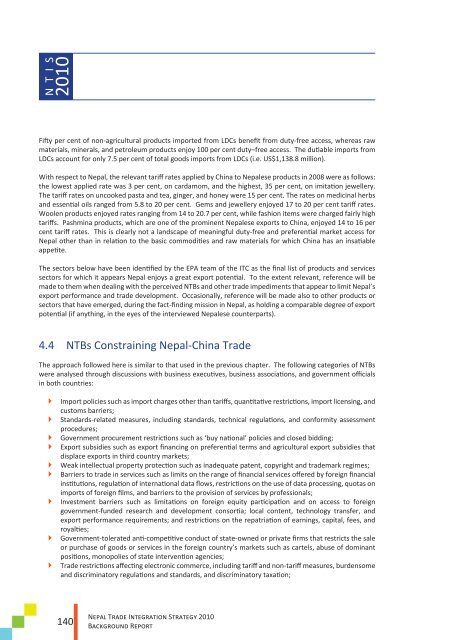Ministry of Commerce And Supplies - Enhanced Integrated ...
Ministry of Commerce And Supplies - Enhanced Integrated ...
Ministry of Commerce And Supplies - Enhanced Integrated ...
You also want an ePaper? Increase the reach of your titles
YUMPU automatically turns print PDFs into web optimized ePapers that Google loves.
N T I S2010Fifty per cent <strong>of</strong> non-agricultural products imported from LDCs benefit from duty-free access, whereas rawmaterials, minerals, and petroleum products enjoy 100 per cent duty–free access. The dutiable imports fromLDCs account for only 7.5 per cent <strong>of</strong> total goods imports from LDCs (i.e. US$1,138.8 million).With respect to Nepal, the relevant tariff rates applied by China to Nepalese products in 2008 were as follows:the lowest applied rate was 3 per cent, on cardamom, and the highest, 35 per cent, on imitation jewellery.The tariff rates on uncooked pasta and tea, ginger, and honey were 15 per cent. The rates on medicinal herbsand essential oils ranged from 5.8 to 20 per cent. Gems and jewellery enjoyed 17 to 20 per cent tariff rates.Woolen products enjoyed rates ranging from 14 to 20.7 per cent, while fashion items were charged fairly hightariffs. Pashmina products, which are one <strong>of</strong> the prominent Nepalese exports to China, enjoyed 14 to 16 percent tariff rates. This is clearly not a landscape <strong>of</strong> meaningful duty-free and preferential market access forNepal other than in relation to the basic commodities and raw materials for which China has an insatiableappetite.The sectors below have been identified by the EPA team <strong>of</strong> the ITC as the final list <strong>of</strong> products and servicessectors for which it appears Nepal enjoys a great export potential. To the extent relevant, reference will bemade to them when dealing with the perceived NTBs and other trade impediments that appear to limit Nepal’sexport performance and trade development. Occasionally, reference will be made also to other products orsectors that have emerged, during the fact-finding mission in Nepal, as holding a comparable degree <strong>of</strong> exportpotential (if anything, in the eyes <strong>of</strong> the interviewed Nepalese counterparts).4.4 NTBs Constraining Nepal-China TradeThe approach followed here is similar to that used in the previous chapter. The following categories <strong>of</strong> NTBswere analysed through discussions with business executives, business associations, and government <strong>of</strong>ficialsin both countries: Import policies such as import charges other than tariffs, quantitative restrictions, import licensing, andcustoms barriers; Standards-related measures, including standards, technical regulations, and conformity assessmentprocedures; Government procurement restrictions such as ‘buy national’ policies and closed bidding; Export subsidies such as export financing on preferential terms and agricultural export subsidies thatdisplace exports in third country markets; Weak intellectual property protection such as inadequate patent, copyright and trademark regimes; Barriers to trade in services such as limits on the range <strong>of</strong> financial services <strong>of</strong>fered by foreign financialinstitutions, regulation <strong>of</strong> international data flows, restrictions on the use <strong>of</strong> data processing, quotas onimports <strong>of</strong> foreign films, and barriers to the provision <strong>of</strong> services by pr<strong>of</strong>essionals; Investment barriers such as limitations on foreign equity participation and on access to foreigngovernment-funded research and development consortia; local content, technology transfer, andexport performance requirements; and restrictions on the repatriation <strong>of</strong> earnings, capital, fees, androyalties; Government-tolerated anti-competitive conduct <strong>of</strong> state-owned or private firms that restricts the saleor purchase <strong>of</strong> goods or services in the foreign country’s markets such as cartels, abuse <strong>of</strong> dominantpositions, monopolies <strong>of</strong> state intervention agencies; Trade restrictions affecting electronic commerce, including tariff and non-tariff measures, burdensomeand discriminatory regulations and standards, and discriminatory taxation;140NEPAL TRADE INTEGRATION STRATEGY 2010BACKGROUND REPORT
















